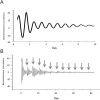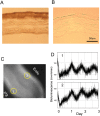Melatonin Entrains PER2::LUC Bioluminescence Circadian Rhythm in the Mouse Cornea
- PMID: 26207312
- PMCID: PMC4516012
- DOI: 10.1167/iovs.15-17124
Melatonin Entrains PER2::LUC Bioluminescence Circadian Rhythm in the Mouse Cornea
Abstract
Purpose: Previous studies have reported the presence of a circadian rhythm in PERIOD2::LUCIFERASE (PER2::LUC) bioluminescence in mouse photoreceptors, retina, RPE, and cornea. Melatonin (MLT) modulates many physiological functions in the eye and it is believed to be one of the key circadian signals within the eye. The aim of the present study was to investigate the regulation of the PER2::LUC circadian rhythm in mouse cornea and to determine the role played by MLT.
Methods: Corneas were obtained from PER2::LUC mice and cultured to measure bioluminescence rhythmicity in isolated tissue using a Lumicycle or CCD camera. To determine the time-dependent resetting of the corneal circadian clocks in response to MLT or IIK7 (a melatonin type 2 receptor, MT2, agonist) was added to the cultured corneas at different times of the day. We also defined the location of the MT2 receptor within different corneal layers using immunohistochemistry.
Results: A long-lasting bioluminescence rhythm was recorded from cultured PER2::LUC cornea and PER2::LUC signal was localized to the corneal epithelium and endothelium. MLT administration in the early night delayed the cornea rhythm, whereas administration of MLT at late night to early morning advanced the cornea rhythm. Treatment with IIK7 mimicked the MLT phase-shifting effect. Consistent with these results, MT2 immunoreactivity was localized to the corneal epithelium and endothelium.
Conclusions: Our work demonstrates that MLT entrains the PER2::LUC bioluminescence rhythm in the cornea. Our data indicate that the cornea may represent a model to study the molecular mechanisms by which MLT affects the circadian clock.
Figures





Similar articles
-
Circadian regulation of the PERIOD 2::LUCIFERASE bioluminescence rhythm in the mouse retinal pigment epithelium-choroid.Mol Vis. 2010 Dec 7;16:2605-11. Mol Vis. 2010. PMID: 21151601 Free PMC article.
-
Valproic acid phase shifts the rhythmic expression of Period2::Luciferase.J Biol Rhythms. 2011 Dec;26(6):541-51. doi: 10.1177/0748730411419775. J Biol Rhythms. 2011. PMID: 22215612
-
An autonomous circadian clock in the inner mouse retina regulated by dopamine and GABA.PLoS Biol. 2008 Oct 14;6(10):e249. doi: 10.1371/journal.pbio.0060249. PLoS Biol. 2008. PMID: 18959477 Free PMC article.
-
The hormone melatonin: Animal studies.Best Pract Res Clin Endocrinol Metab. 2017 Dec;31(6):547-559. doi: 10.1016/j.beem.2017.10.010. Epub 2017 Nov 7. Best Pract Res Clin Endocrinol Metab. 2017. PMID: 29224667 Review.
-
[Effects of melatonin on circadian time keeping system].Nihon Rinsho. 1998 Feb;56(2):302-7. Nihon Rinsho. 1998. PMID: 9503826 Review. Japanese.
Cited by
-
A standardized method to assess the endogenous activity and the light-response of the retinal clock in mammals.Mol Vis. 2020 Mar 4;26:106-116. eCollection 2020. Mol Vis. 2020. PMID: 32180677 Free PMC article.
-
Intrinsically Photosensitive Retinal Ganglion Cells (ipRGCs) Are Necessary for Light Entrainment of Peripheral Clocks.PLoS One. 2016 Dec 16;11(12):e0168651. doi: 10.1371/journal.pone.0168651. eCollection 2016. PLoS One. 2016. PMID: 27992553 Free PMC article.
-
Multiplexed Visualization Method to Explore Complete Targeting Regulatory Relationships Among Circadian Genes for Insomnia Treatment.Front Neurosci. 2022 Jul 1;16:877802. doi: 10.3389/fnins.2022.877802. eCollection 2022. Front Neurosci. 2022. PMID: 35844237 Free PMC article.
-
Melatonin Adjusts the Phase of Mouse Circadian Clocks in the Cornea Both Ex Vivo and In Vivo.J Biol Rhythms. 2021 Oct;36(5):470-482. doi: 10.1177/07487304211032385. Epub 2021 Jul 29. J Biol Rhythms. 2021. PMID: 34323103 Free PMC article.
-
Comprehensive Analysis Identified the Circadian Clock and Global Circadian Gene Expression in Human Corneal Endothelial Cells.Invest Ophthalmol Vis Sci. 2022 May 2;63(5):16. doi: 10.1167/iovs.63.5.16. Invest Ophthalmol Vis Sci. 2022. PMID: 35579906 Free PMC article.
References
-
- Evans JA,, Davidson AJ. Health consequences of circadian disruption in humans and animal models. Prog Mol Biol Transl Sci. 2013; 119: 283–323. - PubMed
-
- Dibner C,, Schibler U. Circadian timing of metabolism in animal models and humans. J Intern Med. 2015; 277: 513–527. - PubMed
-
- Tosini G,, Menaker M. Circadian rhythms in cultured mammalian retina. Science. 1996; 272: 419–421. - PubMed
Publication types
MeSH terms
Substances
Grants and funding
- U54-NS083932/NS/NINDS NIH HHS/United States
- 5U54NS083932/NS/NINDS NIH HHS/United States
- G12 RR003034/RR/NCRR NIH HHS/United States
- R01 EY022216/EY/NEI NIH HHS/United States
- U54 NS083932/NS/NINDS NIH HHS/United States
- SC1 GM112567/GM/NIGMS NIH HHS/United States
- SC1GM112567/GM/NIGMS NIH HHS/United States
- EY020821/EY/NEI NIH HHS/United States
- S21MD000101/MD/NIMHD NIH HHS/United States
- G12-RR03034/RR/NCRR NIH HHS/United States
- R21 EY020821/EY/NEI NIH HHS/United States
- S21 MD000101/MD/NIMHD NIH HHS/United States
- EY022216/EY/NEI NIH HHS/United States
LinkOut - more resources
Full Text Sources
Other Literature Sources
Molecular Biology Databases

